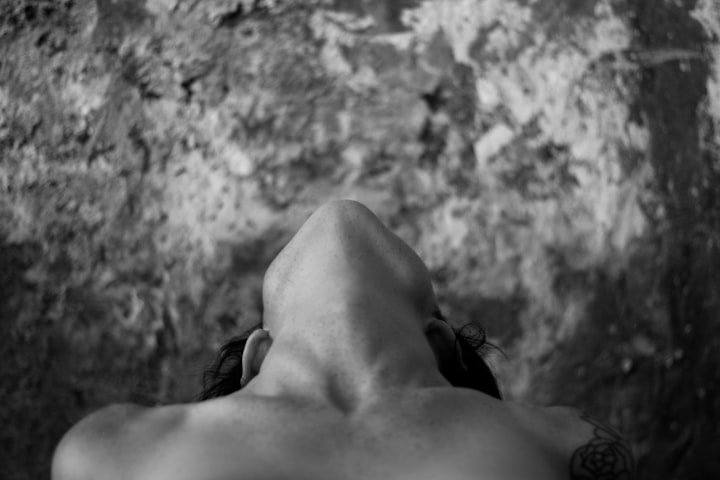
My grandfather was one of the scientists to uncover what today is called the study of endocrinology. Denis (an adaptation of the name Dionysus, the Greek god of bacchanalia) Ikkos was a strict but kind and quiet man with a secret or two glinting in his eye, whose smell of pipe tobacco lingers. It was while watching a presentation at the ten year anniversary of his death - where his legacy to medicine was the centrepiece of the event - that I recognised the diseases that he and his team identified in my own body.
Until then I thought I was just fat and hairy. I often looked at myself in the mirror with a sense of disgust, attacking my reflection with the mantra “fat, hairy bitch”. Suddenly on seeing my ‘worst’ features on the projector described as a symptom, a miracle appeared - if there was a disease, there might be a cure. My father was keen to inform me, “You’re just Greek, there’s nothing wrong with you.” What might be up with the Greek condition is a discussion for another day, but he was right not to let me hypocondricize my pre-teenage body while it still had so much more to discover in itself. Nonetheless, my hunch was right.
Polycystic ovaries, which leads girls and women to have excess weight and hair, is a condition of imbalanced hormones. Some test results later we found out that I did have an excess of testosterone. Then came steroids as well as the contraceptive pill as “treatment” before I had reached the age of 13. Added to which, a mild eating disorder set in when I got to the pressure cooking secondary school age. Soon enough I think all my systems were fried. By the age of 18 I had regular migraines, fluctuating weight, I was still hairy, and my digestive system didn’t know what in and out was. Stopping all western “solutions” in my early 20s, I was very out of control emotionally, intellectually, and physically. It took over a decade of holistic self-care which I crafted through movement practices and breathwork, to address both my mind and body’s needs, and eventually become well again.
It’s a real problem with western medicine, the ignorance of the interwoven systems that our body needs to have in harmony for each to work properly. Hard drugs which present themselves as cures but then create further breakdowns in other areas are dangerous. I was at high risk of stroke for all the time I was on steroids. Little did I know that there are natural remedies for redressing hormonal imbalance. But it isn’t western medicine’s prerogative to prevent sickness, to devalue pharmaceutical drugs, is it?
In ancient traditions such as Yoga and QiGong, the body’s ability and inherent drive to restore its own equilibrium is something taken for granted. That’s why the breath and energy circulation are considered as the foundation of practices designed to prevent diseases. The point of working with the breath and body is to avoid sickness, rather than to allow for it to creep in. Prana Yama, life force, is the key to allowing the body’s own intelligence to restore its optimal functions, through mobilising latently blocked or stored energy.
While the cardiovascular, digestive, urinary, endocrine, lymphatic, and reproductive systems are beyond our conscious control, there is one which is given to us as a gift, a key with which we can reach into all the others. This is the respiratory system. Thanks to the diaphragm, we can send messages to the brain, which in turn services the whole body.
The diaphragm is like a drum which is played by our breath, or better described, the patterns we breathe in create a code that the brain receives. The beat conveys the meaning of the message, designed to inform the brain what environment we are in and which bodily systems it should employ to help us in the specific scenario we find ourselves in. If the breath is short and sharp, the brain interprets our environment to be dangerous. If the breath is gentle and deep, the brain interprets our surroundings as safe. If we’re in danger, in survival mode, the brain shuts down anything we don’t urgently need to survive, to preserve our most vital functions. If we are in safety all our systems are switched on and communicate with one another, sharing the body’s energy to make sure all basic circuits are satisfied. Unfortunately, the status quo today is for the body to be in survival mode, because danger is no longer something isolated, like a killer bear or a tigre. It’s endemic and systemic. It’s the boss who will bully you as long as they can, the threat of war creeping closer, etc.
However, we can change the body’s behavioural patterns so that we are, in spite of our surroundings, at our own best. Today threats exist in our mind (afraid of what the boss might do, anticipating the disaster of war) and so, it’s up to us to manage how they impact our bodies. The diaphragm is our tool for speaking to the brain, and in turn soothing our whole being. Most of us are only using 10% of our diaphragmatic capacity today. We don’t use the diaphragm in full because we don’t have the hunter gatherer lifestyles we were made for. The consequence is that we’re accidentally constantly informing the brain that we are in danger. To remedy this, we need to switch up our use of the diaphragm, which is easy to do through targeted breathing techniques. The diaphragm is a muscle that sits below the rib cage and above the intestines and moves like a pump to cause the lungs to fill with air. When we don’t use its full range of movement, we don’t get as much oxygen into the lungs or organs, nor flush as many toxins as we could from the blood stream, and we limit the electric signals from the brain to the main trunk of the spine (used to govern urgent reactions). When we start to activate the diaphragm, a domino effect takes place whereby the brain relaxes all systems allowing them to communicate with one another. We use the entire spinal column to send electric impulses around the whole body. We facilitate a better exchange of oxygen and carbon dioxide in the blood stream and even increase our tolerance of C02 which gives us a much higher stress threshold, thus more strength in challenging circumstances. Ideally, we want to be able to go to the extremes of stress and relaxation, without causing major disturbance to the heart. The flexibility with which we recover our resting heart rate describes our overall health.
Inspiration. What does that word say to you? It’s the moment between breaths when we’re in surrender to the unknown, when something can take us by surprise. Literally it is the moment that the breath drops in. If you’ve ever felt what it means to let your body take over and to quiet the mind, it’s like becoming one with everything around you. We live in complete denial of our insignificance, and paradoxically, this blocks our sense of power and wonder. In allowing the mechanics of our organism to show us what nature has to offer us, we gain an ability that feels like flying. By focusing on the breath it is possible to transcend the physical body and gain sensory perception of what is both inside us and around us. Meditation practices train the brain and body to make sense of intero-perception (feeling the activity of our heart, lungs, even blood, or ovulation) and extero-perceptions (the sounds of our environment, the wind on our skin, the gravitational pull of objects in our space, the falling of light). Breathwork adds another level of processing. It directly releases emotional locks that the skeletal and muscular system write into us. Every time a jaw clenches, each frog that gets stuck in the throat, any butterflies ever felt in the belly, leave a mark in time on the body like footsteps in sand. Breathwork serves to wash them away through a recirculation of energy around the body. By quieting the mind and opening the heart, we allow the past to inform us without letting it trap us. We make space for the inspiration to take us somewhere new and beyond our imagination. Inspiration is metaphorically that moment of genius when we identify what was always there waiting for invention, unseen until we had the information needed to perceive it. Inspiration and expiration, breathing, is in itself a cycle of life and death, which allows for the constant process of renewal in the body to take place at the deepest level.
The pandemic has unleashed a wave of respiratory maladies, indicating that our respiratory systems are indeed weak in this day and age. Below is a small list of books containing all the information you need to awaken to the importance of fixing the respiratory system you have, which in turn will remedy the other bodily functions. Making the transition from survival mode to a state of feeling safe - a process that breathwork directly and immediately facilitates - is the first step towards caring for our own wellbeing.
The feeling of safety can only be cultivated with an intention of kindness. Today I talk to the girl I called a “fat, hairy bitch” very differently. To my inner child I say “You’re absolutely beautiful and full of radiant life force. You have no idea how much strength is in your hair, you have no idea what force is in your body. Life with all its challenges will show you. Facing the challenges, meeting yourself where you are, and loving yourself for who you are will set you free.”
Recommended reads :
https://www.mrjamesnestor.com/
https://oxygenadvantage.com/
https://www.wimhofmethod.com/the-wim-hof-method-book
About the Creator
Lia Ikkos
The Singer Wrong Writer; London born, world raised. Lover of languages, liquorice, and horses.
Theatre Maker, Performer, Writer. See performance work at www.liaikkoscreative.com
Follow me @liaikkos






Comments
There are no comments for this story
Be the first to respond and start the conversation.